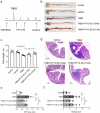Peptide YY 3-36 attenuates trinitrobenzene sulfonic acid-induced colitis in mice by modulating Th1/Th2 differentiation
- PMID: 35443853
- PMCID: PMC9161959
- DOI: 10.1080/21655979.2022.2064147
Peptide YY 3-36 attenuates trinitrobenzene sulfonic acid-induced colitis in mice by modulating Th1/Th2 differentiation
Abstract
Peptide YY (PYY) 3-36, the main circulatory form of PYY, plays important roles in gastrointestinal motility, secretion, and absorption. However, it is unknown whether PYY 3-36 has underlying functions in colitis. The Crohn's disease (CD)-like mouse model in which CD is induced by trinitrobenzene sulfonic acid (TNBS) was established and utilized to investigate this potential role for PYY 3-36. The results showed that the expression of colonic mucosal PYY and PYY receptors Y1, Y2, Y4 were significantly increased in mice with TNBS-induced colitis. In vitro, PYY 3-36 remarkably inhibited the production of proinflammatory cytokines tumor necrosis factor-α (TNF-α) and interleukin-6 (IL-6) from lipopolysaccharide (LPS)-induced macrophages. In vivo, a high concentration of PYY 3-36 robustly decreased the weight loss and death rate and attenuated the pathological colon tissue damage observed in mice with TNBS-induced colitis. Further studies uncovered that PYY 3-36 treatment reduced the levels of colon myeloperoxidase (MPO) and both colonic and systemic TNF-α and IL-6 observed in murine colitis. Furthermore, flow cytometric analysis showed PYY 3-36 altered the proportion of Th1/Th2 splenocytes in the disease model of colitis. Collectively, these results suggest that PYY 3-36 may be a promising candidate for the improvement of colitis, reflected by the attenuation of colon inflammatory responses observed in experimental murine colitis.
Keywords: PYY 3–36; Th1/Th2 cells; colitis; inflammation; trinitrobenzene sulfonic acid.
Conflict of interest statement
No potential conflict of interest was reported by the author(s).
Figures







References
-
- El-Salhy M, Hausken T.. The role of the neuropeptide Y (NPY) family in the pathophysiology of inflammatory bowel disease (IBD) [J]. Neuropeptides. 2016;55:137–144. - PubMed
-
- Torres J, Mehandru S, Colombel JF, et al. Crohn’s disease [J]. Lancet. 2017;389(10080):1741–1755. - PubMed
-
- Gren ST, Grip O. Role of monocytes and intestinal macrophages in crohn’s disease and ulcerative colitis [J]. Inflamm Bowel Dis. 2016;22(8):1992–1998. - PubMed
MeSH terms
Substances
LinkOut - more resources
Full Text Sources
Medical
Research Materials
Miscellaneous
